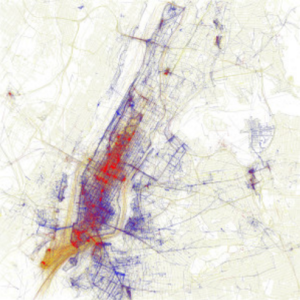I’ve always said that if a visitor really wants to feel connected to a great city, they need to get away from the tourists and experience that city like the locals. This is not always easy to do, especially in a place as compact and tourist-intensive as New York City. But if more authentic tourism is a priority for you, the products of a fascinating new bit of data analysis might prove invaluable.
New York City. Blue dots represent photos taken by locals. Red dots are photos taken by tourists. I suggest tourists make an effort to see the blue places and not worry much about the red.
A fan of photography and maps named Eric Fischer analyzed Twitter to identify a ridiculous number of geolocated photographs taken in major cities. He then looked at an individual photo-tweeter’s tweeting history to determine whether or not he or she likely lived in that city or was just passing through. Having made that differentiation, he divided the photographs up into groups taken by likely tourists or locals, plotting color coded dots (red for tourist, blue for local) on a map. Looking at the distribution of red versus blue dots suggests Fischer’s tourist identification algorithm did a good job of assigning individuals to the appropriate category. The result is deeply compelling for a number of reasons.
For one, it’s a wonderful example of secondary and tertiary insights that can be gained from the analysis of big data sets. Big data analysis is all the rage these days.
Second, it’s a good example of the kind of innovative data mashups made possible by public access to the APIs of firms like Google and Twitter. APIs are awesome.
Third, and of greatest practical importance, maps like these make it easy for out-of-towners to immediately identify the places that locals value enough to photograph, yet where tourists tend not to go. So in the case of New York City, one can immediately eliminate Times Square, 30 Rockefeller Center, Grand Central Station, and the entire Financial District, opting instead for places like the East Village, Williamsburg, Downtown Brooklyn, Hoboken, and Gramercy Park.
Take a moment to look at all the cities Fischer compiled tourist versus local data for. Beyond being useful, they are all beautiful and compelling in and of themselves.


